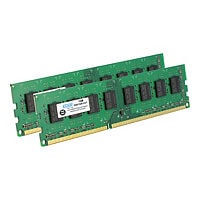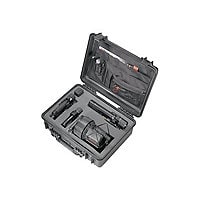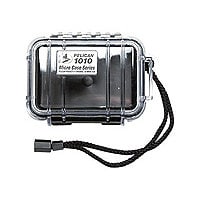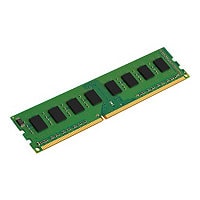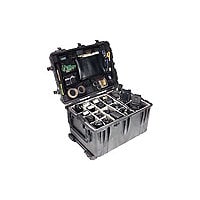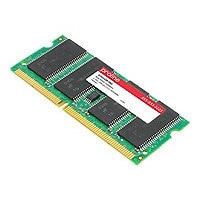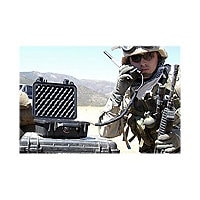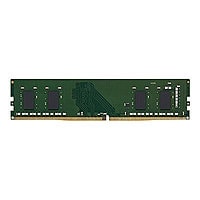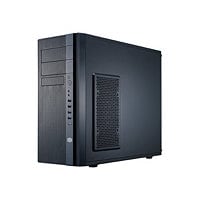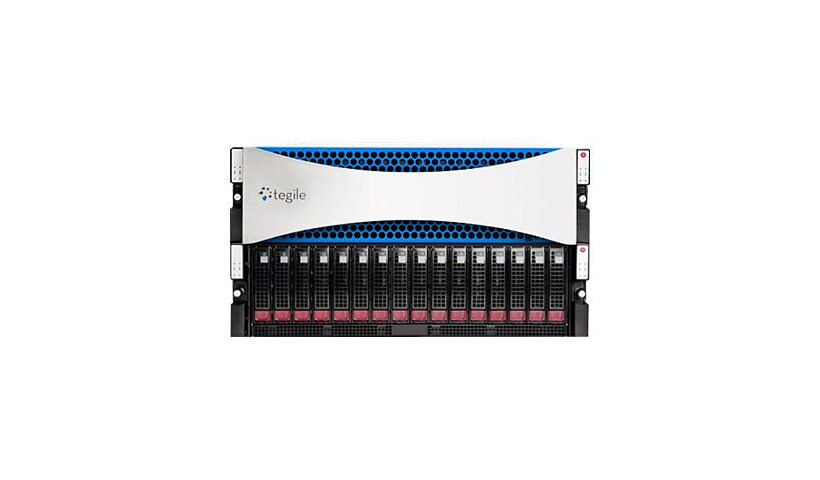
Know your gear
Enhance your purchase
Top Rated Products
TEGILE XEON T4200 FLASH 2-CTRL4 52TB is rated
4.10 out of
5 by
8.
Rated 5 out of
5 by
Anil Rahulwar from
Good customer service and support and suitable for large environments
What is our primary use case?
We use IntelliFlash products for larger environments, like Qatar Airways. They have large scalability and use more than a thousand disks.
So, in terms of scalability, the solution is very good.
What is most valuable?
The AI features are good. We don't need to search for anything; everything is built-in.
What needs improvement?
DDN IntelliFlash should improve in terms of sales.
In future releases, I look forward to more features about AI and ML features.
For how long have I used the solution?
I have been using it for more than two years.
What do I think about the stability of the solution?
I haven't faced any challenges in the last two years. They have deployed some bugs and fixed them in every OS version.
The stability is good. I would rate the stability a nine out of ten.
What do I think about the scalability of the solution?
It is a scalable product. I would rate the scalability a nine out of ten.
How are customer service and support?
The customer service and support respond within five to ten minutes whenever there's an issue.
How would you rate customer service and support?
Positive
Which solution did I use previously and why did I switch?
I have worked on Dell and Panzura products, as well as DDN products. I prefer DDN products.
How was the initial setup?
It is very easy to install. Users don't need to remember anything while deploying IntelliFlash because everything will be taken care of by tech support. They can easily modify the installation or change the password with the help of the tech support.
It is very easy to integrate IntelliFlash with other solutions. We have plugins that can be integrated with other solutions.
It will require maintenance. It is the same as any other storage solution: updates and upgrades, firmware upgrades, and drive upgrades.
What about the implementation team?
One person is enough for the deployment.
What was our ROI?
ROI is in terms of time savings.
What's my experience with pricing, setup cost, and licensing?
It is a bit cheaper than other products, 10% to 20% cheaper.
What other advice do I have?
I would recommend it to others. Overall, I would rate it a nine out of ten.
Disclaimer: I am a real user, and this review is based on my own experience and opinions.
Date published: 2024-07-28T00:00:00-04:00
Rated 5 out of
5 by
RRuttkowski from
It provides a combination of protocols without losing deduplication and compression.
How has it helped my organization?
Moving over from NetApp to Tegile was easy because of the software completion. It was less complex to install. It takes around twenty minutes to activate storage.
What is most valuable?
It provides a combination of all the protocols that you need, without losing deduplication and compression. It is easy to manage and control.
What needs improvement?
The system has been used, but not with all the features in it. One feature that could improve is Call-Home alerts. At the moment, the system allows access to the internet directly or over a proxy, but in the proxy section you can’t choose a user account and password, so it is not allowed at the moment to go out, if customer has such constellation.
In case of security it is important for my customer to control any access from out to in and vice versa. The issue is addressed to Tegile and will be a part of one of the next patch in summer 2017.
What do I think about the stability of the solution?
There were no stability issues. It’s what the customer expects from a storage solution with five nines availability.
What do I think about the scalability of the solution?
There were no scalability issues. It is easy to expand. Performance is the same or equal to the number of shelves you add, because every shelf is SSD-powered.
This is greatly different to the NetApp solution, which the customer had used before. If you add shelves in NetApp, then the performance goes down.
How is customer service and technical support?
The technical support team is perfect. They are fast and competent.
Which solutions did we use previously?
We have used NetApp and the reason why we switched was due to the overall cost. After five years, the cost decreases over 30% and the performance increases over 50%.
How was the initial setup?
As mentioned before, it takes around twenty minutes to go into production. The setup was easy and has a clear Web UI.
After the system starts, you change the IP, make the array active, build a LUN, and then present it to vSphere. That’s all.
Which other solutions did I evaluate?
We did a complete evaluation, in terms of an ROI of the competitor products. (This is a specialty of our company.)
NetApp, Atlantis USX, and SimpliVity were the products we evaluated. We also looked into sourcing to a provider.
What other advice do I have?
All the features should be calculated with the company's cost and effect to the business. Every company has its own DNA, so the best solution for each business differs.
Disclaimer: My company has a business relationship with this vendor other than being a customer:We are partners, but not on a reselling level, only for getting all the technical information of these systems. Use our expertise and call us (www.holistic3.com), for a complete vendor independent ROI.
Date published: 2017-05-10T00:00:00-04:00
Rated 5 out of
5 by
it_user657768 from
The extra capacity has allowed us to consolidate most of our storage onto one platform.
How has it helped my organization?
The extra capacity has allowed us to consolidate most of our storage onto one platform.
What is most valuable?
High performance and ease-of-management are the most valuable features.
What needs improvement?
It's annoying that if you turn on SMB3 (as opposed to the earlier CIFS protocol), then it is not possible to access a file store using a mixture of SMB and NFS. This is a serious restriction for a multi-protocol file server.
Snapshots are not as easy to access as on a NetApp device.
What do I think about the stability of the solution?
We have not had issues with stability.
How is customer service and technical support?
Support has been good, although we haven't needed to use it much.
Which solutions did we use previously?
We switched from NetApp, mainly due to cost.
How was the initial setup?
The setup was reasonably straightforward, although the documentation could be improved in terms of the networking.
Which other solutions did I evaluate?
We evaluated NetApp.
What other advice do I have?
It's a good product with good support. I would recommend it.
Disclaimer: I am a real user, and this review is based on my own experience and opinions.
Date published: 2017-05-10T00:00:00-04:00
Rated 5 out of
5 by
it_user535977 from
The most valuable features are multipathing and Easy Tier.
How has it helped my organization?
Being able to add additional disks to a volume to expand. For example, for RAID-5 mdisk/volume, add three additional disks in RAID-5 and expand the existing data.
What is most valuable?
* The most valuable features are multipathing and Easy Tier.
* EasyTier/hotcaching: Valuable because it allows greater performance than standard SAS disks
* Cheaper than pure solid state without needing to actively manage where the data is located.
* Multipathing: Provides redundancy by allowing each host to have multiple paths to storage, protecting against NIC/drive/storage processor failure
What needs improvement?
No issues so far.
What do I think about the scalability of the solution?
We did not have scalability issues.
How is customer service and technical support?
I would give technical support a rating of 7/10.
Which solutions did we use previously?
We used EMC and IBM. We got a good deal on Storewize and 6GB SAS connectivity was a better performance/value option compared to 1GB or 10GB Ethernet iSCSI.
How was the initial setup?
The initial setup was straightforward.
What's my experience with pricing, setup cost, and licensing?
It's good.
Which other solutions did I evaluate?
We evaluated EMC VNXe3150.
What other advice do I have?
I don’t have any advice.
Disclaimer: My company has a business relationship with this vendor other than being a customer:We are a reseller.
Date published: 2017-05-10T00:00:00-04:00
Rated 5 out of
5 by
Reviewer903 from
Improved throughput throughout our organization, and very robust
What is our primary use case?
It is our primary shared storage. Primary uses are to support virtual machines and SQL database.
How has it helped my organization?
It has improved throughput throughout the organization. Our entire server stack runs on this. It has cut batch job runtime in half, so we're seeing performance improvement throughout the organization.
What is most valuable?
It's very fast. We were seeing read latencies of less than one millisecond. It is robust. This is our second Tegile product, so we are happy with the company and their support.
It's very flexible. It has features we don't even use at this point.
What needs improvement?
It does what we need.
What do I think about the stability of the solution?
Very stable, just like the other Tegile array that we had, which was a hybrid array. Not as high performance, but always very solid, very stable.
What do I think about the scalability of the solution?
I would say it's somewhat scalable, maybe not so much as some of the competition, but we don't really care. It has more capacity than we need. We're not even likely to upgrade it.
How is customer service and technical support?
For the previous box we used tech support on a couple of occasions, and we used their tech support to do the installation of this box. They're very competent.
Which solutions did we use previously?
We were using another Tegile product, a hybrid array, and were seeing average latencies of about eight milliseconds, but we were seeing spikes up to 50 milliseconds, and when that happened everything slowed down. We were looking for a performance improvement across the board.
When selecting a vendor I would say
* price
* performance
* support
would be our top criteria.
How was the initial setup?
I was not involved personally in the setup. We have a network administrator and he worked with the Tegile engineer to set it up. But I think it was pretty straightforward.
Which other solutions did I evaluate?
This time around it was Tegile versus Pure Storage. We went with Tegile, because they made us a good offer, and we were happy with them from our previous experience.
What other advice do I have?
We don't really have any other comparison. We're perfectly happy with it, so I'd have to give it a 10 out of 10.
I would tell colleagues to at least consider Tegile. They're not as big a name, they were probably left off your list. However, they are financially stable now that Western Digital is backing them, and it's a good product.
Disclaimer: I am a real user, and this review is based on my own experience and opinions.
Date published: 2018-04-29T00:00:00-04:00
Rated 5 out of
5 by
it_user495576 from
One can learn this data compression tool fairly quickly.
What is most valuable?
* Ease of Use: Someone can learn it in only few hours
* Performance: Easy Tier is doing miracles
* Data Compression: Up to 80% space reduction in the database
What needs improvement?
Performance supervision: It only keeps one hour of real-time data without the ability to do deep analysis of each element.
What do I think about the stability of the solution?
We have not had stability issues.
What do I think about the scalability of the solution?
We have not had scalability issues.
How is customer service and technical support?
Technical support is quite good, even though there is room for improvement.
Which solutions did we use previously?
We wanted ease of use and storage savings.
How was the initial setup?
It is easy to do the initial installation/configuration. It is intuitive and well documented.
What's my experience with pricing, setup cost, and licensing?
I recommend the full bundle software in order to have all the functionality. It is more expensive to purchase it one by one.
What other advice do I have?
You will be quite surprised by the ease of use.
Disclaimer: My company has a business relationship with this vendor other than being a customer:We are a business partner.
Date published: 2017-05-10T00:00:00-04:00
Rated 5 out of
5 by
reviewer1634190 from
A unified flash storage solution with poor performance, support, and features
What is our primary use case?
We use IntelliFlash for our virtualization environment. We use VMware, and it's used to show the virtual machines.
What is most valuable?
The initial setup is straightforward.
What needs improvement?
I wouldn't say I like anything about this solution. We are looking for a replacement with Dell EMC and Pure Storage. Tegile's performance, support, and features are horrible. It's going down.
Multiple companies have bought it. It looked okay at one point in time, like four years ago. Even though it wasn't one of the best, it still looked okay. Since the management has changed several times, it looks like it's going down the drain.
Performance is horrible now. Our original intent was to buy new storage in about two years. But since it became a critical urgency for us, we decided to purchase a new one in two or three months.
It would be better if they improved the codebase. We have issues very often with their code, and I think that is the main pain point. The hardware is also horrible because we have either a controller failure or a SATADOM failure very often. Now and then, we also have a disc failure.
They have to get their act together. They have to make sure their hardware is robust, they have to make sure their code is good, and then we can think about new features and functionality.
First, make the unit run properly, and then we can think about additions. Obviously, their support has to be knowledgeable. Because when I told them, "we have latency issues, come troubleshoot it for us," nobody came. But if we tell them that "we need to do a firmware upgrade," then they are like, "okay. Let's do a firmware upgrade." They will come to do the firmware upgrade, and then they will go. But with the firmware upgrades, you might never know when it works properly and when it doesn't work properly.
If there is a disc that needs to be replaced, and we ask them to replace it, they'll say, "okay, just share the remote station with us, and we'll run some commands, and we'll validate which disc is faulty. If it's really faulty, we will send the disc. We do that, and then they find the faulty disc and send a replacement.
They will do these minor things. But that's not what we are looking for. We are looking for more features and more functionality. Like if there is latency, try to help us out and help the customer find where the latency is. It doesn't necessarily have to be only with SAN storage. It might be a configuration issue, or it might be something else. So, you should help the customer find where the issue is. Unfortunately, that is not what we are getting from them. So they have to improve that a lot.
For how long have I used the solution?
I have been using IntelliFlash for the past four years.
What do I think about the stability of the solution?
IntelliFlash isn't stable at all. Its performance is horrible.
What do I think about the scalability of the solution?
I don't think there's any scalability. From the outside, it looks awesome. But performance-wise, it's not good. You just have to buy new arrays if you want to scale. It's not like a traditional SAN where you just add in a bunch of this or that and start increasing your capacity. It's not like that. We have 4,000 virtual machines and about 1,000 people using them.
How are customer service and technical support?
Technical support is horrible. Their support is not able to handle the volume of issues. It's indirectly affecting the support system. Even though you create a ticket, it looks like they know what the issue is, and they don't have a fix for it. So, they don't really respond to you.
Even though they release a fix and apply it, you get some other issue in two or three days. They have to go back to engineering again and get that resolved. We have been spending a lot of time with that array, which, ideally, we should not be doing. But unfortunately, that's the situation where we are in.
They are seriously bad. For example, we had virtual machines which were having high latencies. What do you do when you have virtual machines with high latency? You look at the application, you look at the virtual environment, and you look at the SAN switches, and you also look at the SAN storage. When I created a ticket, VMware hopped on very quickly. Then they looked at the thing, and they said, "oh, yeah, everything is good." I know everything is good, but still, I had to create a ticket as per our policy. Then I did the same with SAN storage. They responded after a day, saying, "okay, do one thing and just create a ticket. Set up a call with VMware so that we can work with them."
If that is what they want, then I'm going to set up a call with VMware and rope them in. I set up a call and roped them in. They didn't really attend to the call until now. It's been four months, and we haven't heard from them. I had to work with VMware. We had to make some changes, but still, there is a latency issue. That's why our management is like, "okay, we had enough of this company, let's go ahead and get a new one."
On a scale from one to ten, I would give their technical support a one.
How was the initial setup?
The initial setup was straightforward. There weren't really many features or functionality for this product. It was very simple. You didn't need a storage administrator to manage it, and it was straightforward initially. It was good and took about a day to deploy this solution.
What about the implementation team?
Initially, we used the help of a consultant to implement this solution. Our experience with them was okay. It wasn't bad.
Maintenance over the last year has become horrible. We had to dedicate one person or an administrator to do maintenance on these units. It's every day for maybe four hours on average.
What's my experience with pricing, setup cost, and licensing?
I think we pay around 100 grand per year for three arrays or four arrays.
What other advice do I have?
I would tell potential users not to implement Tegile. We are leaning towards Pure Storage. We found it more stable when we did our research, and many people seem to be happy with it. It looks like the management will make the final decision, and we should be going towards Pure.
On a scale from one to ten, I would give IntelliFlash a one.
Which deployment model are you using for this solution?
On-premises
Disclaimer: I am a real user, and this review is based on my own experience and opinions.
Date published: 2021-08-06T00:00:00-04:00
Rated 5 out of
5 by
reviewer1643715 from
Good features with an easy initial setup but technical support is slow
What is our primary use case?
We used the solution basically for all operations. We got our ERP, Citrix, email (there was about a two wall to 18 terabytes with email), et cetera, that we had on the hybrid and we had our ERP system, which demands performance. We had that on the solution's all-flash.
How has it helped my organization?
It improved a lot of our processes and especially our ERP. Our reports were taking from six to eight hours to do. Once we got this solution in there, we were able to get the reporting down from eight hours to under 20 minutes. Ultimately, we were able to deploy to get the reports in under five minutes, which was a huge accomplishment.
What is most valuable?
There were some good features. It did provide the call home, which was a great feature when it worked.
It performed great originally, and when it performed great, it was awesome.
The initial setup was fine.
What needs improvement?
Once you started pushing it, it would start to not respond properly and then we would have to reach out to support, to try to figure out where these issues came from. They couldn't tell us where the problems were. Their advice was simply to take some load off and then it would work fine.
Sometimes there was imprecise information. If there's an issue with the system, to kind of pinpoint where the issue was coming from, for example, if it was network latency or a load link to a VM or load link to some kind of switch, it would have been helpful to know.
I know they can't look at all the networks, however, as the solution is connected to VMware and the SAN and the switch, there should be more information on the system. I can't pinpoint anything, which is a problem. Their reporting needs to be much better.
For how long have I used the solution?
I've used the solution for five years.
What do I think about the stability of the solution?
The solution as it is right now is not very stable. The stability seems to have eroded. It's gotten to the point we are concerned about crashes.
What do I think about the scalability of the solution?
The scaling is okay. We can scale it up, however, the problem with our scaling is how do you scale up something that, when it was sold to us, was already on the way out at an end of life. Therefore, while we can scale up, we're going to scale up an unsupported product.
Their approach is "Hey, listen, let's just buy a new product. And then you scale of the new product even better."
With the scalability of the product when I purchased it, I was able to add four flash arrays, and we could add four hybrid storage drives.
We have 300 to 400 people on the solution currently.
How are customer service and technical support?
When we first got the product, support was amazing, however, that is no longer the case.
Technical support is bad. It'd grade them at 30% or 40%. The response time is terrible. I had a major issue with things that were not working. I'd asked them for an ETA and they would make it more about them than us. It would be more than six hours before anybody would get back to me. That was unacceptable, especially when it's slow when it doesn't take it all the way down, yet slows everything down to the point where it's not working. While we're down they're treating the situation as not important enough to do a response time within an hour. I just find that unacceptable.
Which solution did I use previously and why did I switch?
We're using HP. We moved over due to the fact that the product was declining, and we could get much better support and reporting elsewhere.
How was the initial setup?
The setup was pretty straightforward, however, when we received this version, we had a lot of problems. They had to replace the controller at least twice within the first three months. The guys did a great job, however, we might have gotten a bad batch of controllers, as we seemed to have many problems within the first six months.
The deployment was fast and on the first day, it was up and running, ready for our support.
We have two people that handle maintenance. It's pretty easy to take care of and they've found it easy to learn. They are network systems admins. They are just junior admins and they are able to handle everything with no problem.
What about the implementation team?
We did the integration and installation in conjunction with an Intelliflash support engineer. They're good. They're above average. Originally, when Intelliflash was Tegile, the support engineers were knowledgeable of whatever they ran, and they had the patience to assist and were very helpful.
What's my experience with pricing, setup cost, and licensing?
I'm not sure of the exact pricing. Over three years, the support might have been in the ballpark of $15,000. We bought the solution itself outright.
Which other solutions did I evaluate?
Before we purchased this product, we were actually going to go with the HP brand called Nimble. We're familiar with the all-flash array technology. This solution was a good fit when it first came out. However, some of the politics and the management of the system that can support it are no longer there.
What other advice do I have?
We are a customer and an end-user.
The solution is now out of support, however, we were using the most recent version of the product.
I tell my guys when they're looking for a solution, is focus on the technology, of course, and focus on the SLA and the response time. The difference between what I have now and the current solution is the response time. If I made a call now, in less than 10 minutes we get a level three engineer. That's important. As much as I have great IT sys admins and they can resolve anything, sometimes it's just about being able to call at any time and have somebody there that knows what he's talking about and is able to help us from a level three perspective.
I'd rate the solution at a seven. It's a good product, however, their technical support is very bad.
Which deployment model are you using for this solution?
On-premises
Disclaimer: I am a real user, and this review is based on my own experience and opinions.
Date published: 2021-08-25T00:00:00-04:00



